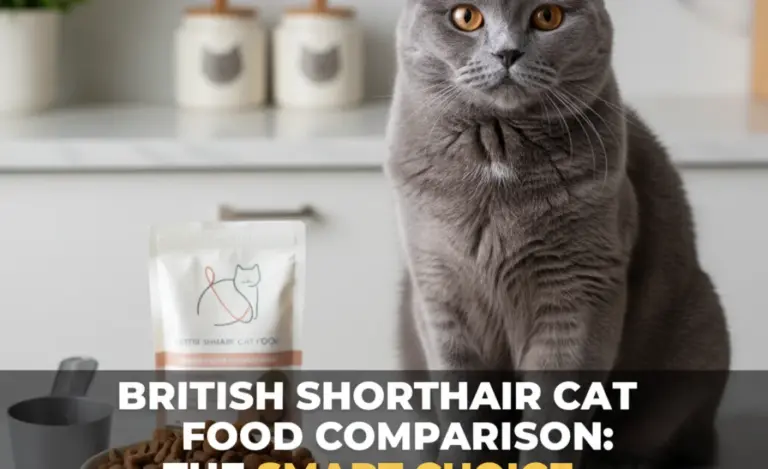British Shorthair Metabolism-Boosting Diet: Secret?
A British Shorthair metabolism-boosting diet focuses on high-quality protein, controlled portions, and regular exercise. Choose wet food with high moisture content and consider supplements like L-Carnitine. Regular playtime is key to keeping your British Shorthair active and maintaining a healthy weight. Avoid overfeeding and provide fresh water at all times.
Is your British Shorthair a little too round? Many owners struggle to keep their beloved cats at a healthy weight. British Shorthairs are prone to weight gain, which can lead to serious health issues. But don’t worry! With the right diet and a bit of activity, you can boost your cat’s metabolism and help them live a longer, happier life.
In this article, I’ll walk you through a simple, step-by-step approach to creating a metabolism-boosting diet for your British Shorthair. We’ll cover everything from choosing the right food to incorporating fun exercise routines. Get ready to learn how to keep your furry friend in tip-top shape!
Understanding British Shorthair Metabolism
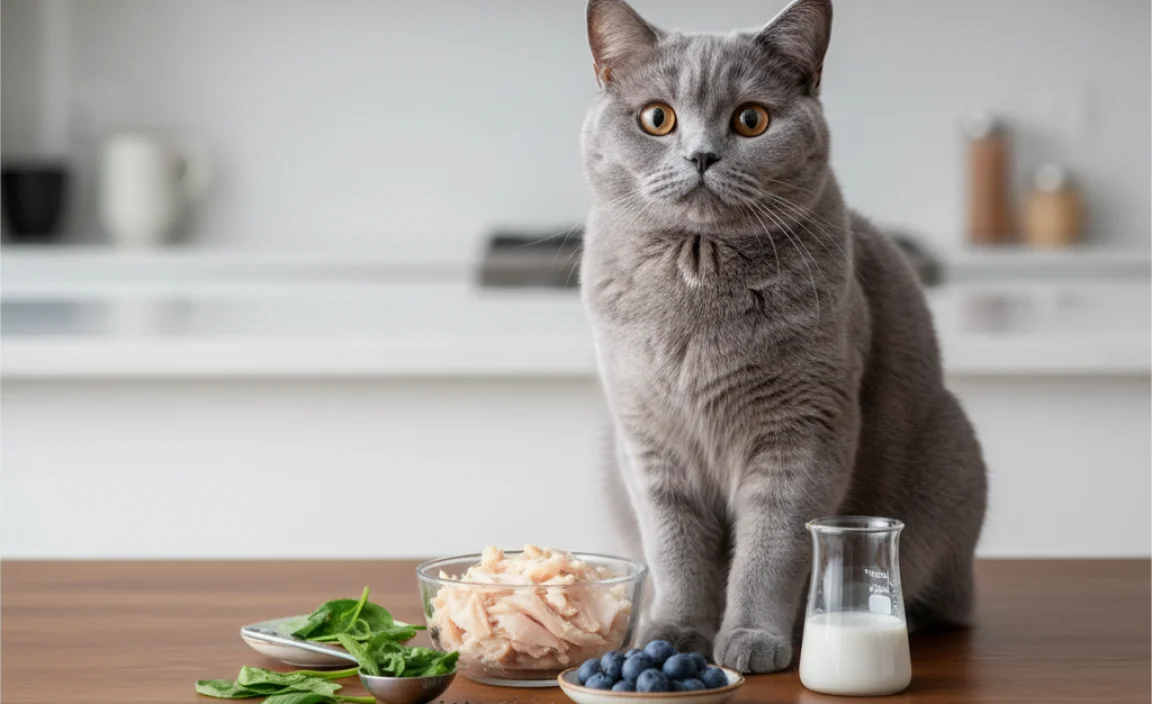
Before diving into specific diets, it’s important to understand why British Shorthairs are prone to weight gain. These cats have a naturally laid-back temperament and a tendency to be less active than some other breeds. This can slow down their metabolism, making them more likely to pack on the pounds. According to the RSPCA, maintaining a healthy weight is crucial for preventing health problems like diabetes and joint issues in cats.
A healthy metabolism ensures your cat efficiently converts food into energy. When metabolism slows, excess calories are stored as fat. Factors influencing a British Shorthair’s metabolism include:
- Age: Kittens have faster metabolisms than senior cats.
- Activity Level: Active cats burn more calories.
- Diet: High-quality protein boosts metabolism.
- Genetics: Some cats are naturally predisposed to weight gain.
Recognizing these factors will help you tailor a diet that meets your cat’s specific needs and keeps their metabolism humming.
Step 1: Choosing the Right Cat Food
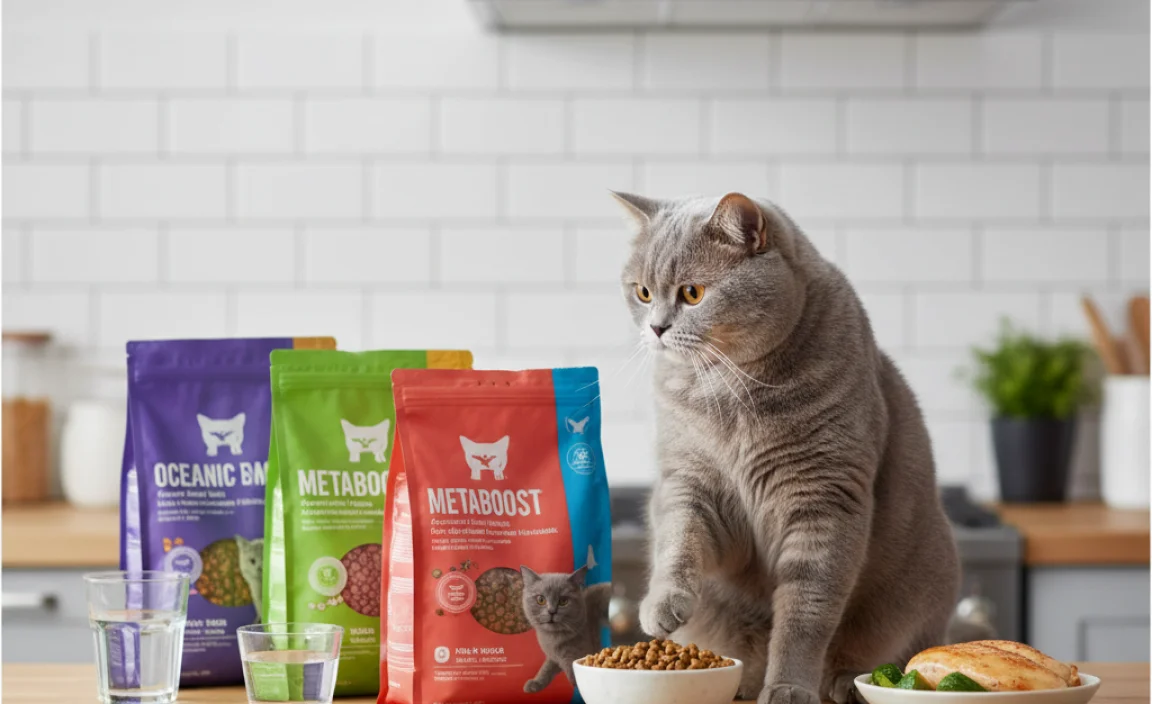
Selecting the right cat food is the foundation of a metabolism-boosting diet. Look for foods that are high in protein and low in carbohydrates. Protein helps build lean muscle mass, which burns more calories than fat. Always read the ingredient list carefully. The first ingredient should be a named meat source, such as chicken, turkey, or fish.
Dry vs. Wet Food
Both dry and wet food have their pros and cons. Dry food is convenient and can help maintain dental health, but it’s often higher in carbohydrates. Wet food has a higher moisture content, which is beneficial for hydration and can help your cat feel fuller for longer. Many vets recommend a combination of both to get the benefits of each.
Here’s a quick comparison:
| Type of Food | Pros | Cons |
|---|---|---|
| Dry Food | Convenient, good for dental health | Often high in carbs, lower moisture |
| Wet Food | High moisture, helps with satiety | Can be more expensive, spoils quickly |
Ingredients to Look For
- High-Quality Protein: Chicken, turkey, fish
- Low Carbohydrates: Avoid fillers like corn, wheat, and soy
- Healthy Fats: Omega-3 and Omega-6 fatty acids
- Added Vitamins and Minerals: Essential for overall health
Avoid foods with artificial colors, flavors, and preservatives. These additives offer no nutritional value and can sometimes cause allergies or sensitivities.
Step 2: Portion Control and Feeding Schedule
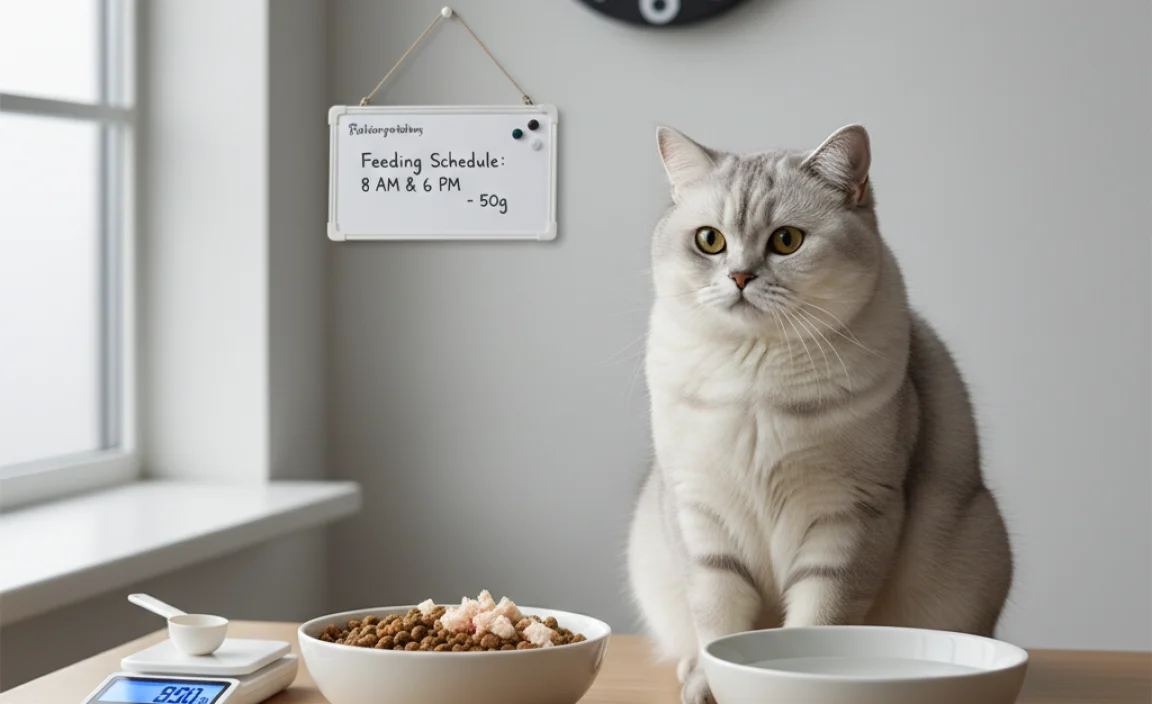
Even the best cat food won’t help if you’re overfeeding your British Shorthair. Portion control is essential for maintaining a healthy weight. Consult the feeding guidelines on your cat food packaging, but remember that these are just general recommendations. You may need to adjust the amount based on your cat’s individual needs and activity level.
Measuring Food
Use a measuring cup to ensure you’re feeding the correct amount. Avoid free-feeding, where food is available at all times, as this can lead to overeating. Instead, establish a consistent feeding schedule.
Recommended Feeding Schedule
A good feeding schedule involves feeding your cat two to three small meals per day. For example:
- Morning: Small portion of wet food
- Afternoon: Small portion of dry food
- Evening: Small portion of wet food
This helps regulate their metabolism and prevents them from feeling hungry between meals. Always provide fresh water alongside their food.
Step 3: Incorporating Exercise and Play
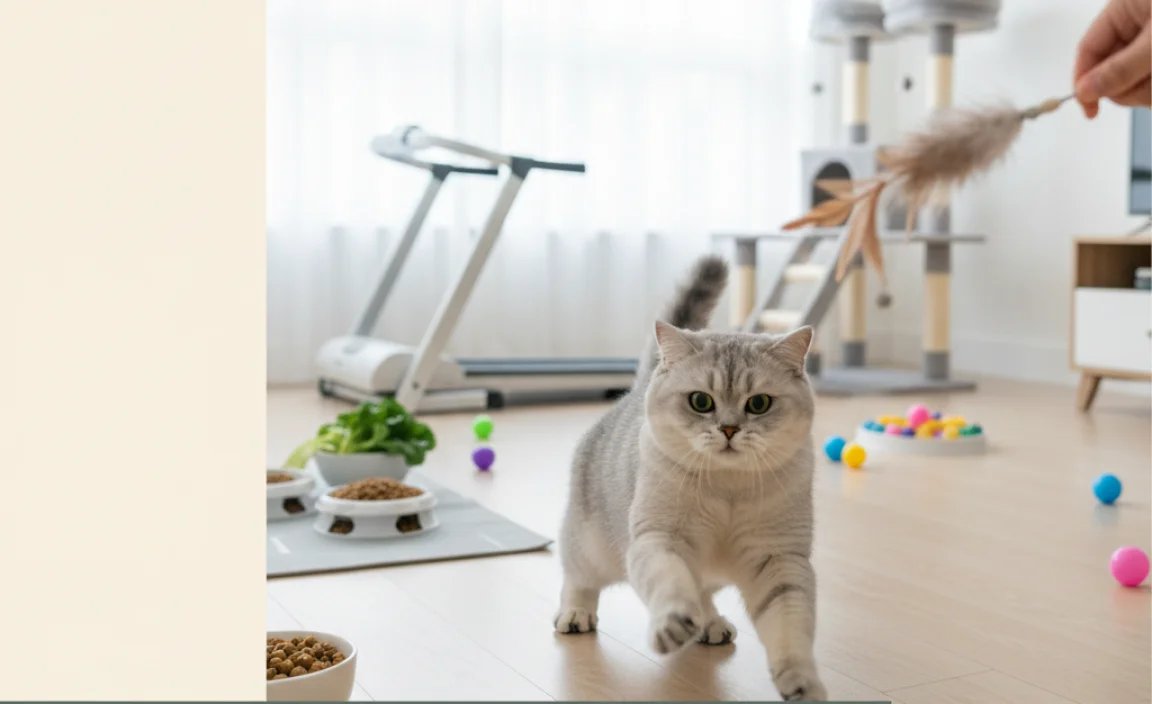
Exercise is just as important for cats as it is for humans. Regular playtime helps burn calories, build muscle, and keep your British Shorthair mentally stimulated. Aim for at least 15-20 minutes of active play each day.
Types of Exercise
- Interactive Toys: Feather wands, laser pointers, and toy mice
- Climbing Trees: Encourages vertical movement and exploration
- Puzzle Feeders: Stimulates their mind and slows down eating
- Training: Teach your cat simple tricks for mental and physical exercise
Make playtime fun and engaging. Rotate toys to keep your cat interested and motivated. According to The International Cat Association (TICA), regular play not only helps with weight management but also strengthens the bond between you and your cat.
Step 4: Supplements to Boost Metabolism
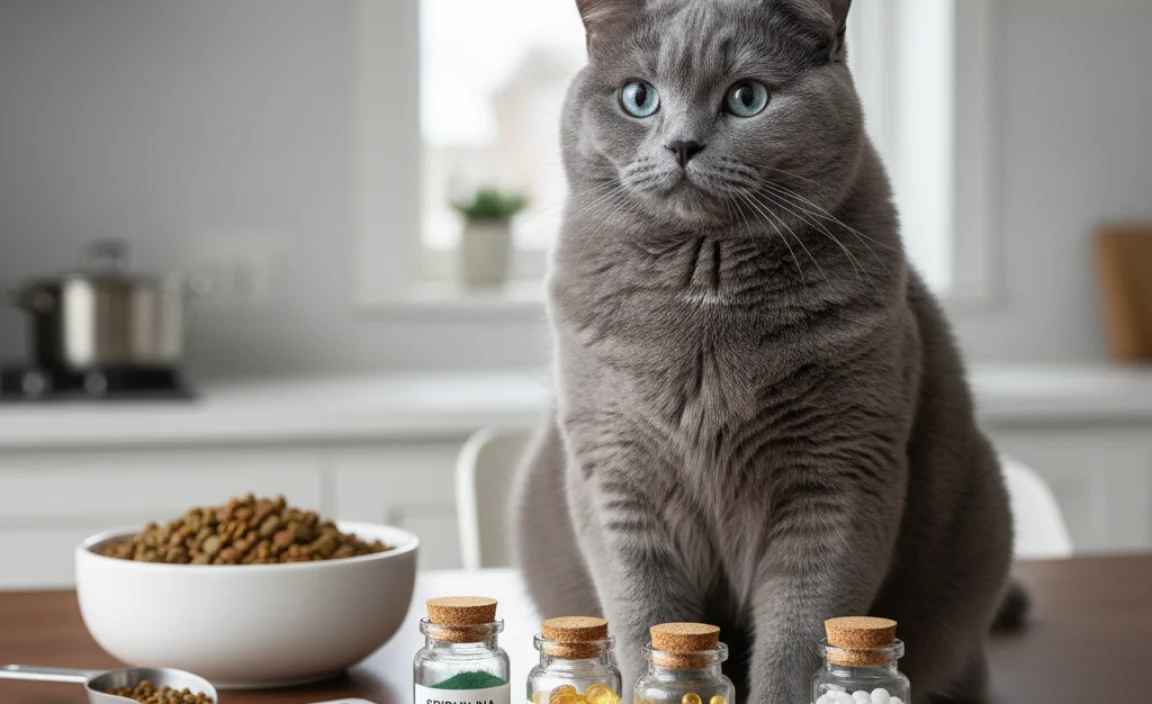
Certain supplements can help boost your British Shorthair’s metabolism and support their overall health. Always consult with your vet before adding any supplements to their diet.
L-Carnitine
L-Carnitine is an amino acid that helps the body convert fat into energy. It’s often recommended for overweight cats to help them burn fat more efficiently. A study published in the Journal of Animal Physiology and Animal Nutrition found that L-Carnitine supplementation can improve fat metabolism in cats.
Omega-3 Fatty Acids
Omega-3 fatty acids, found in fish oil, have anti-inflammatory properties and can support joint health. They also play a role in metabolism by improving insulin sensitivity. Look for a high-quality fish oil supplement specifically formulated for cats.
Probiotics
Probiotics support a healthy gut microbiome, which is essential for digestion and nutrient absorption. A balanced gut can improve metabolism and overall health. Choose a probiotic supplement that contains multiple strains of beneficial bacteria.
| Supplement | Benefits | Dosage |
|---|---|---|
| L-Carnitine | Helps convert fat into energy | Follow vet’s recommendation |
| Omega-3 Fatty Acids | Anti-inflammatory, supports joint health | Follow product instructions |
| Probiotics | Supports gut health, improves digestion | Follow product instructions |
Step 5: Monitoring Your Cat’s Weight and Adjusting the Diet
Regularly monitoring your British Shorthair’s weight is crucial for ensuring their diet is effective. Weigh your cat every few weeks and keep a record of their progress. You can also assess their body condition by feeling their ribs. You should be able to feel their ribs easily without pressing too hard, but they shouldn’t be visible.
Signs of a Healthy Weight
- You can feel their ribs without pressing too hard.
- They have a visible waist when viewed from above.
- They have a healthy amount of energy and activity.
Adjusting the Diet
If your cat is losing weight too quickly, increase their food portions slightly. If they’re not losing weight or are still gaining, reduce their portions or increase their activity level. It’s a balancing act that requires patience and observation. Always consult with your vet if you have concerns or if your cat has underlying health issues.
Step 6: Hydration is Key
Proper hydration is vital for a healthy metabolism. Cats often don’t drink enough water, which can lead to dehydration and other health problems. Make sure your British Shorthair always has access to fresh, clean water. Consider using a water fountain, as many cats prefer running water.
Tips for Encouraging Hydration
- Use a Water Fountain: Cats are attracted to moving water.
- Provide Multiple Water Bowls: Place bowls in different locations.
- Add Wet Food to Their Diet: Wet food has a high moisture content.
- Flavor the Water: Add a small amount of tuna juice or chicken broth.
Dehydration can slow down metabolism and affect overall health, so make hydration a priority.
Step 7: Regular Vet Check-ups
Regular vet check-ups are an essential part of maintaining your British Shorthair’s health. Your vet can assess their overall condition, identify any underlying health issues, and provide personalized recommendations for their diet and exercise. The Cornell Feline Health Center recommends annual check-ups for adult cats and more frequent visits for kittens and senior cats.
What to Expect During a Vet Check-up
- Physical Examination: Checking their weight, body condition, and vital signs.
- Blood Tests: Assessing organ function and identifying potential health problems.
- Vaccinations: Protecting against common feline diseases.
- Parasite Control: Preventing and treating fleas, ticks, and worms.
Don’t hesitate to discuss any concerns you have about your cat’s weight or metabolism with your vet. They can provide valuable guidance and support.
FAQ: British Shorthair Metabolism-Boosting Diet
Here are some frequently asked questions about boosting your British Shorthair’s metabolism:
What is a healthy weight for a British Shorthair?
A healthy weight for a British Shorthair typically ranges from 8 to 17 pounds. However, this can vary depending on their size and build. Consult your vet for personalized advice.
How often should I feed my British Shorthair?
Feed your British Shorthair two to three small meals per day. This helps regulate their metabolism and prevents overeating.
Can I give my British Shorthair treats?
Yes, but give treats in moderation. Choose healthy, low-calorie options and factor them into their daily calorie intake.
Is dry or wet food better for boosting metabolism?
Wet food is generally better due to its higher moisture content and lower carbohydrate levels. A combination of both can be beneficial.
How can I tell if my British Shorthair is overweight?
You can tell if your British Shorthair is overweight if you can’t easily feel their ribs, they lack a visible waist, and they have low energy levels.
What are some good exercises for British Shorthairs?
Good exercises include interactive play with feather wands, laser pointers, and climbing trees. Puzzle feeders can also provide mental stimulation.
Are supplements necessary for boosting metabolism?
Supplements like L-Carnitine and Omega-3 fatty acids can be helpful, but they’re not always necessary. Consult your vet before adding any supplements to your cat’s diet.
Conclusion
Boosting your British Shorthair’s metabolism is all about making informed choices and creating a lifestyle that supports their health and well-being. By choosing high-quality food, controlling portions, incorporating regular exercise, and staying vigilant about their health, you can ensure your feline friend stays happy, active, and at a healthy weight. Remember, every cat is unique, so tailor your approach to meet their specific needs. With a little patience and dedication, you can help your British Shorthair thrive for many years to come.



